This post may contain affiliate links. At no cost to you, purchases made through these links may result in a small commission for Traveling Transylvania. We never recommend products that we don’t know and trust. Thank you for your continued support!
Ever dreamt of wandering through a village that feels like a seamless blend of history, enchantment, and timeless beauty? Welcome to Viscri, Romania. As soon as you set foot here, you’ll realize it’s not just another destination—it’s a journey back in time.
But Viscri is not just about its age-old tales. The landscapes are an enchantment in themselves. Rolling hills? Absolutely. Traditional Saxon houses? Indeed. Picturesque avenues that lead to stories untold? Certainly. Every nook and cranny of this beautiful Romanian village offers a moment of discovery, making it an alluring canvas for both history buffs and curious souls.
And the heart of it all? The iconic Viscri Fortified Church, standing tall, echoing tales of yesteryears and beckoning travelers from afar. Like the perfect dish in an acclaimed eatery, this church complements the charm of Viscri in ways words often fall short of describing.
Viscri, nestled in the heart of Transylvania, is that hidden gem that promises a whirlwind of emotions, sights, and sounds. Whether you’re drawn to its rich history, the royal connections, or the sheer beauty of rural Transylvania, you’re embarking on an experience that will linger in your memories for years to come.
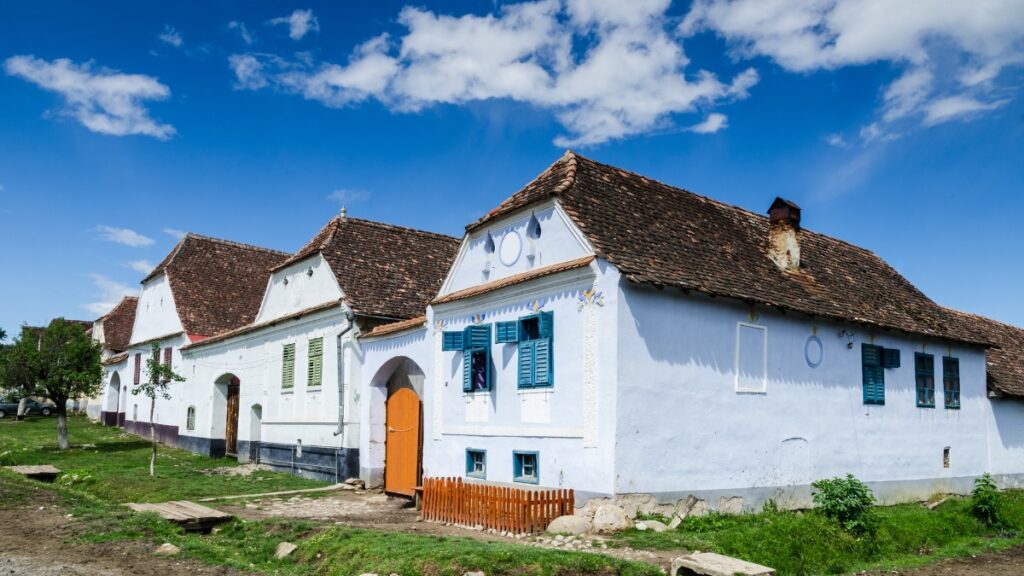
A Peek into the Past: History of Viscri Village
Viscri, originally known as Weisskirch in German, finds its roots in the 12th century. Established by the Székelys, Transylvania’s earliest settlers, the village later saw an influx of Saxon colonists in the 12th and 13th centuries. These Saxons not only enriched Viscri’s culture but also played a pivotal role in its defense against external invasions.
Viscri’s iconic fortified church, built in the early 13th century, stands as a testament to the village’s strategic significance. Initially constructed as a small chapel, it was later fortified in the 16th century, reflecting the region’s need for heightened defense against Ottoman invasions. With walls measuring up to three meters thick, multiple defensive levels, and a tower overlooking the village, the church became Viscri’s protective core.
Over the centuries, Viscri witnessed various rulers, from the Kingdom of Hungary to the Ottoman Empire, and later, the Austro-Hungarian Empire. Each era left its imprint, shaping Viscri’s unique cultural mosaic. In the 20th century, much of its Saxon population emigrated, yet their architectural and cultural legacy remains intact.
In 1993, Viscri’s fortified church and the village’s preserved architectural style earned it a deserving spot on the UNESCO World Heritage list, along with a number of other villages with Fortified Churches in Transylvania. This recognition played a significant role in shining a global spotlight on Viscri, drawing attention to its rich historical tapestry and unique Saxon heritage.
This small village, nestled in the heart of Transylvania, stands not just as a geographical location, but as a chronicle of epochs, invasions, migrations, and preservation. Each brick in its streets and each mural in its church narrates tales of bygone eras, inviting history enthusiasts and curious travelers to delve deeper into its captivating past.
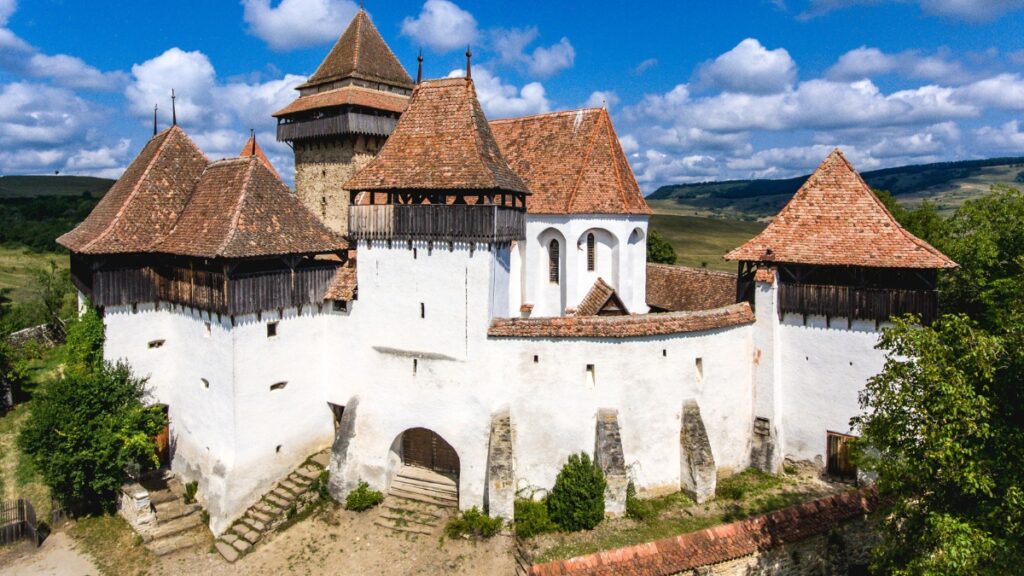
The Gem of Viscri: The Fortified Church
Dotted amidst the pastoral landscapes of Viscri is its crowning glory: The Fortified Church. This monument isn’t merely a structure of bricks and mortar but stands as a beacon of Viscri’s rich heritage. Its imposing towers and robust walls are emblematic of the architectural prowess of the Saxons and their deep-rooted commitment to safeguarding their community.
The tales of the Viscri Fortified Church stretch back to the 13th century. Originally constructed as a small chapel, its significance and structure grew with the village. Over time, as threats from marauding invaders became recurrent, the need for a fortified sanctuary became evident.
The church transformed, not just as a spiritual refuge but also a physical one, with the village’s inhabitants seeking shelter within its sturdy walls during turbulent times. Its walls have withstood sieges, witnessed celebrations, and offered solace – becoming silent spectators to Viscri’s evolving tale.
The Viscri Fortified Church’s design is an amalgamation of utility and aesthetics. The church is encircled by defensive walls, equipped with archer slits and watchtowers. Yet, within these walls, the beauty unfolds in its Gothic-style altar, vivid frescoes, and the delicate play of light through its stained-glass windows. Each element, whether defensive or decorative, tells a tale of the village’s past.
The church isn’t a relic frozen in time. It remains an active part of the community’s life. Services, celebrations, and festivals – the fortified church has continually served as a backdrop, linking generations and bridging the past with the present.
In a village as enchanting as Viscri, the Fortified Church stands tall, not just in stature but in its significance. A visit here is not merely about admiring an ancient structure, but immersing oneself in a story that has been written over centuries and continues to unfold with every dawn.
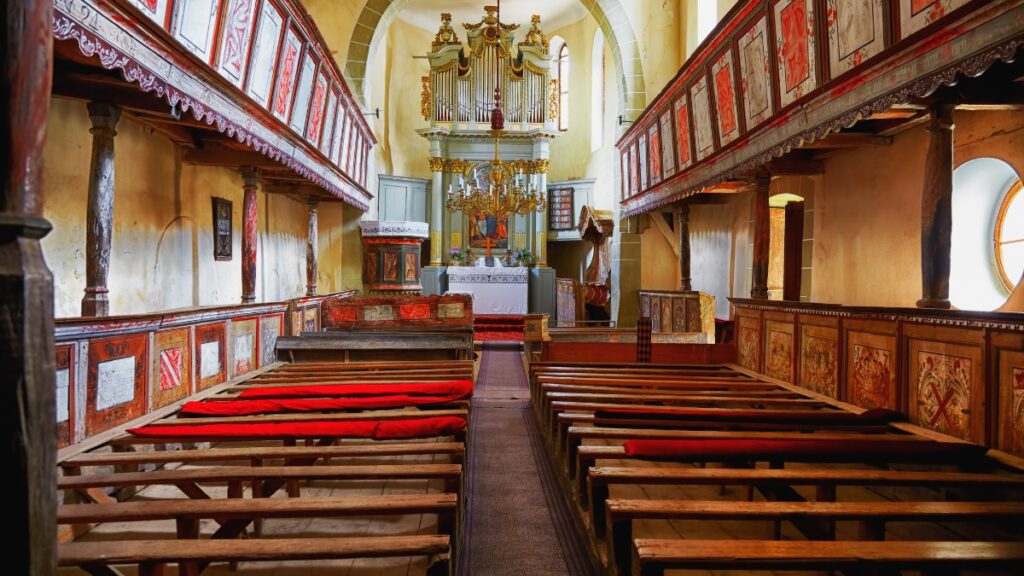
Royal Connections: The Royal Family’s Bond with Viscri
In a world where modernity often overshadows tradition, Viscri’s untouched charm caught the eye of an unlikely visitor: Prince Charles of Wales. His first tryst with this picturesque village was not merely a fleeting visit. Instead, it sparked a profound connection, transforming into a romance that’s celebrated by both the village and the prince.
Prince Charles’s fondness for Viscri isn’t limited to mere admiration. Over the years, he became deeply involved in preserving its rich heritage. Through various initiatives, he championed the restoration of old Saxon houses, breathing life into structures that time had nearly forgotten. His commitment to sustainable tourism highlighted Viscri on the global map, introducing travelers to its understated allure.
The royal family’s association with Viscri did more than just bring attention. It revitalized the local community, fostering a sense of pride in their heritage. The village saw a resurgence of traditional crafts, the melodies of folklore echoed louder, and Viscri became a symbol of conservation done right.
In the annals of Viscri’s history, Prince Charles’s chapter is relatively recent. Yet, its impact is profound. It’s a testament to how one individual’s passion can shine a light on a hidden gem, ensuring that its stories, culture, and beauty continue to be celebrated by generations to come.
Through the prince’s eyes, the world rediscovered Viscri, and in its cobblestone streets and ancient walls, he found a haven far removed from the regal corridors of Buckingham Palace.
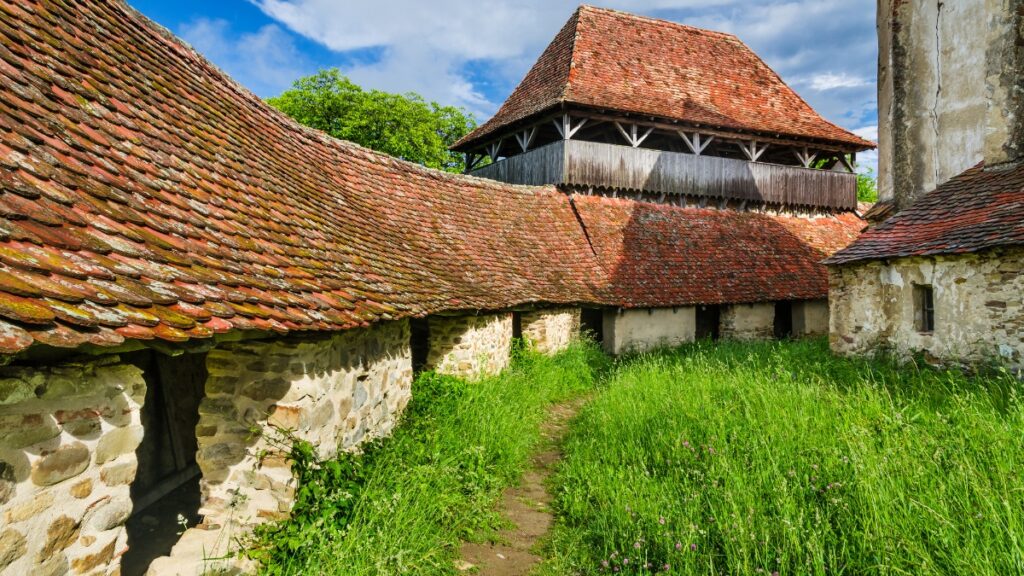
Viscri Today: Exploring the Heart of Transylvania
Walking through Viscri feels akin to stepping into a time capsule. Despite the passage of centuries, the village retains its age-old charm, almost untouched by the modern world.
Traditional Saxon houses line the streets, their distinctive colors and architecture offering glimpses into a bygone era. Locals go about their daily chores, cultivating their fields, herding their livestock, and welcoming travelers with warm smiles, ensuring that the essence of Viscri remains undiluted.
The rise in global recognition hasn’t turned Viscri into a mere tourist hotspot. Efforts, largely inspired by Prince Charles’s vision, have been directed towards sustainable tourism. Visitors are not mere spectators; they’re encouraged to immerse themselves in the local traditions, participate in traditional crafts, and savor authentic Transylvanian cuisine. This approach not only offers a richer experience but also ensures that tourism benefits the community directly.
While the Fortified Church might be its crowning glory, Viscri has more to offer. Engage in a village walk, and you’ll uncover stories hidden in its corners. Participate in workshops that teach traditional crafts, from pottery to weaving. Savor local delicacies, each telling a tale of its own. For the adventurous, the surrounding countryside offers opportunities for hiking, horse-riding, and even bird-watching.
In the heart of Transylvania, Viscri stands as a testament to how places can retain their soul, even in the face of growing global attention. Whether it’s the allure of history, the beauty of its landscapes, or the warmth of its people, Viscri promises a travel experience that goes beyond mere sightseeing. It’s about feeling, understanding, and becoming a part of a story that has been unfolding for centuries.
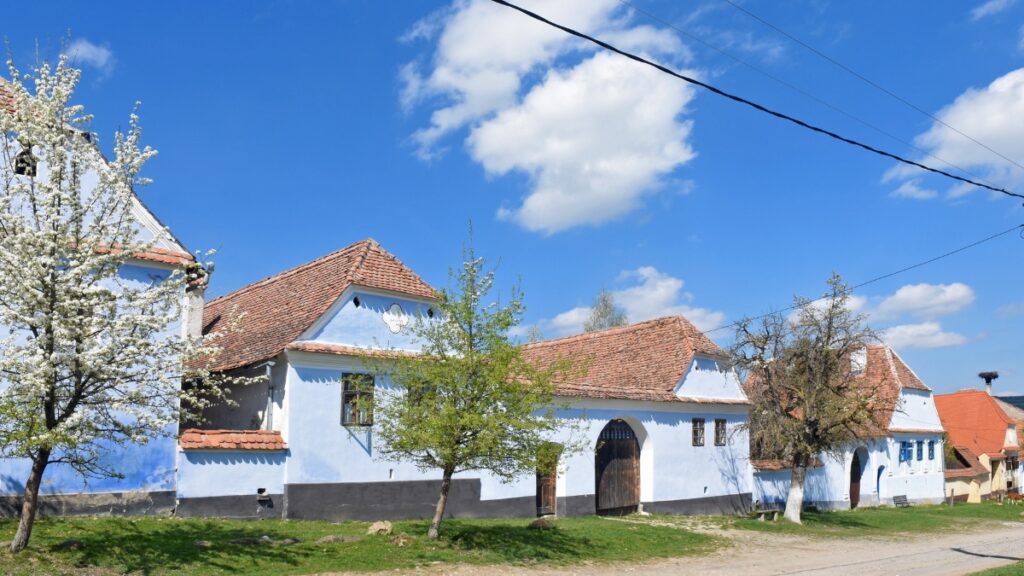
How to Get to Viscri
Bucharest to Viscri
Distance: Approx. 280 km
Driving Time: Around 4-5 hours, depending on traffic and specific route taken.
Public Transport: Yes, there are buses and trains connecting Bucharest to Brasov, from where you can take another bus or taxi to Viscri. Direct connections might be limited, so planning in advance is advisable.
Beginning your journey from the capital city? Reaching Viscri from Bucharest is both convenient and scenic. Whether you opt for a drive through the picturesque landscapes or choose the comfort of public transport, the roads meander through some of Transylvania’s most captivating sights, making the journey as memorable as the destination.
Brasov to Viscri
Distance: Approx. 100 km
Driving Time: Approximately 2-2.5 hours.
Public Transport: Limited bus services are available from Brasov to Viscri. It might be more convenient to rent a car or take a taxi for this relatively short distance.
Brasov, with its blend of medieval charm and urban sophistication, serves as a popular starting point for many traveling to Viscri. The route from Brasov to Viscri winds through the Carpathian foothills, offering panoramic views and glimpses of rustic Transylvanian life.
Sighișoara to Viscri
Distance: Approx. 30 km
Driving Time: Around 45 minutes to 1 hour.
Public Transport: Given the close proximity, buses are sporadic. Taxis or rented cars are the most reliable modes of transport for this route.
What better way to travel to Viscri than via another iconic Transylvanian gem? The journey from the citadel town of Sighisoara to Viscri is a short one, but it’s packed with history and scenic beauty, making it a favorite among travelers.
Cluj-Napoca to Viscri
Distance: Approx. 230 km
Driving Time: Roughly 3.5-4 hours.
Public Transport: Buses and trains connect Cluj-Napoca to Brasov. From Brasov, one can take another bus or taxi to Viscri. Direct routes might be limited, so it’s best to check schedules ahead of time.
Starting from the bustling city of Cluj-Napoca? The route to Viscri offers a transition from urban landscapes to the serene Transylvanian countryside. As you move closer to Viscri, the hustle and bustle of city life fades, replaced by the tranquil rhythms of rural Romania.
Sibiu to Viscri
Distance: Approx. 150 km
Driving Time: About 2.5-3 hours.
Public Transport: Buses are available from Sibiu to Brasov, and from there, Viscri can be reached by another bus or taxi. Direct connections to Viscri from Sibiu might be rare, so planning the route in stages is recommended.
From the cultural capital of Sibiu, the journey to Viscri is a delightful drive. Passing through traditional villages and vast green landscapes, this route offers travelers a taste of the region’s rich cultural tapestry.
Each journey to Viscri offers unique landscapes and cultural insights. Regardless of your starting point or mode of transport, the essence of Transylvania will slowly unfold, setting the stage for the magic of Viscri. Always remember to check the latest transport schedules and road conditions in advance, ensuring a smooth and memorable journey.
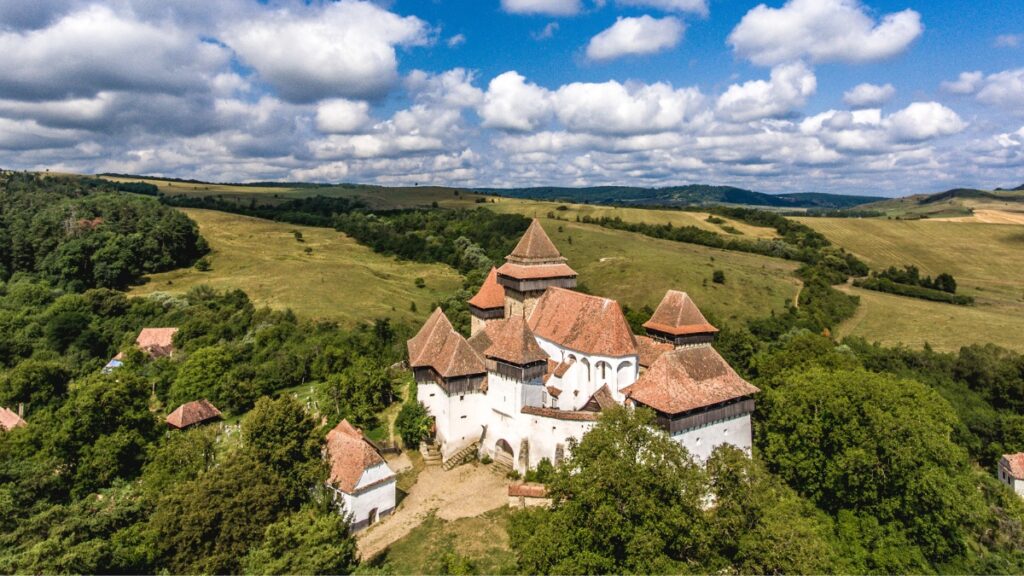
Embracing the Magic of Viscri
Drenched in whimsy and steeped in history, Viscri stands as an evocative portrait of Transylvania’s captivating charm. It’s not just a village. Viscri is a realm where stories come alive, dancing in the shadows of the fortified church, echoing in the cobbled streets, and residing in the hearts of the warm villagers.
From its regal connections that reverberate with Prince Charles’s dedication to the rustic beauty that seems to have been untouched by the hands of time, Viscri Romania beckons travelers with an allure that’s both enigmatic and enlightening.
Make your way to this village, be it from the bustling avenues of Bucharest or the medieval allure of Sighisoara. You’re not just traveling across distances; you’re journeying through layers of tales that this region has woven for centuries.
So, whether it’s the UNESCO-stamped legacy of the Viscri fortified church that calls out to you, the inviting narratives of its age-old streets, or the promise of an immersive Transylvanian experience, know this: a trip to Viscri isn’t just a checkbox on a travel itinerary. It’s a soulful sojourn that promises memories drenched in wonder, leaving you enchanted long after you’ve departed its magical embrace.
When in Transylvania, let Viscri be your storybook, where every corner narrates a tale, every stone has a legend, and every moment is nothing short of enchanting. Dive in, for the magic awaits!

